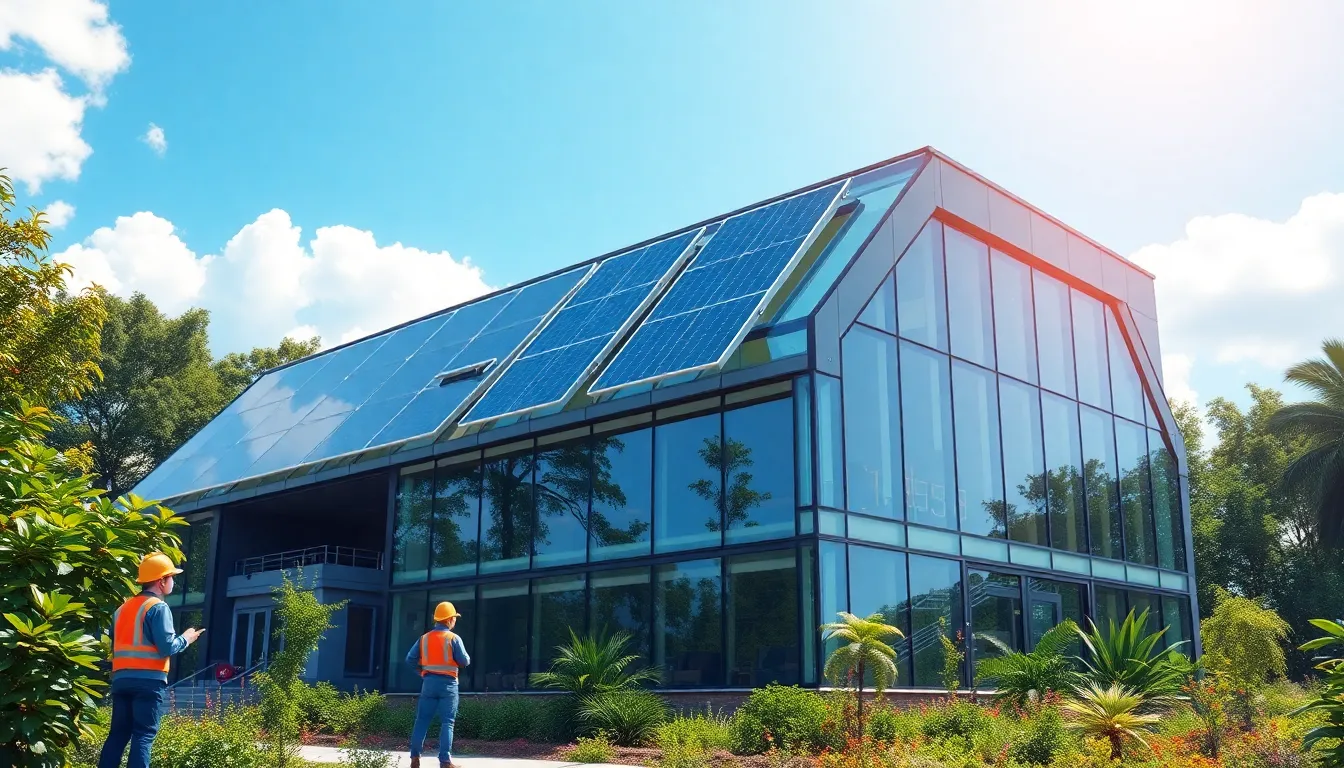In a world where climate change is the hottest topic—literally—sustainability in real estate is no longer just a trend; it’s a necessity. Developers and homebuyers alike are trading in their old habits for eco-friendly innovations that not only save the planet but also save some serious cash. Who knew that going green could be so stylish?
Table of Contents
ToggleReal Estate Sustainability Trends Overview
Sustainability in real estate has become essential as concerns about climate change escalate. Developers increasingly incorporate eco-friendly designs into projects, focusing on energy efficiency and resource conservation. Green building materials often feature in modern construction practices, contributing to sustainable development.
Homebuyers prioritize energy-efficient features when searching for new properties. Smart home technology plays a significant role in reducing energy consumption, prompting a greater demand for these innovations. Water-saving fixtures, solar panels, and better insulation strengthen the appeal of sustainable homes.
Investors recognize the long-term financial benefits of green buildings. Properties with sustainability certifications can command higher rents or sale prices. Many investors seek out developments that minimize environmental impacts while maximizing returns.
Green certifications, such as LEED and BREEAM, are gaining popularity. These certifications provide a framework for understanding a building’s sustainability practices. Adopting such standards not only improves marketability but enhances overall building performance.
Renewable energy integration has seen dynamic growth in real estate trends. Many developers install solar panels and wind turbines to offset energy costs. Sustainable landscaping practices also contribute to reducing water usage and improving biodiversity.
Sustainability initiatives often align with government regulations and incentives. Cities and municipalities are increasingly pushing for energy-efficient buildings through grant programs. Compliance with these regulations not only fosters environmental responsibility but influences market competitiveness.
Enhancing urban spaces with green infrastructure also remains a focus. Incorporating parks, green roofs, and permeable surfaces contributes to overall community well-being. Real estate sustainability trends reflect a collective shift toward an environmentally responsible future.
Current Trends in Sustainable Building Practices

Sustainable building practices are gaining traction in the real estate market. Developers and homeowners prioritize energy efficiency and environmental responsibility.
Energy Efficiency Innovations
Innovative energy solutions are reshaping properties today. Technologies like smart thermostats and LED lighting reduce energy consumption significantly. Solar panels generate clean electricity, while energy-efficient windows minimize heat loss. Building automation systems enhance efficiency by optimizing heating and cooling based on occupancy. These advancements not only lower utility costs but also improve residents’ comfort levels. The adoption of energy-efficient designs is becoming a key decision factor for buyers seeking long-term value.
Use of Sustainable Materials
Sustainable materials play a critical role in eco-friendly construction. Recycled steel and bamboo provide sturdy alternatives to traditional resources. Low-VOC paints improve indoor air quality and minimize environmental impact. Moreover, reclaimed wood adds aesthetic value while reducing waste. The shift towards sustainable options reflects a growing awareness of environmental footprints in building practices. Consequently, using these materials not only attracts eco-conscious buyers but also contributes to overall sustainability in real estate.
The Role of Technology in Sustainability
Technology plays a crucial role in advancing sustainability in real estate. Developers and homeowners increasingly rely on innovative solutions to enhance energy efficiency and reduce environmental impacts.
Smart Home Features
Smart home features are becoming essential for eco-friendly living. Programmable thermostats allow for precise temperature control, significantly lowering energy consumption. Smart lighting systems adjust automatically based on occupancy, ensuring energy isn’t wasted. Additionally, energy monitoring devices provide real-time feedback on energy usage, helping homeowners make informed decisions about their consumption. With these technologies, homebuyers prioritize energy-efficient features, increasing demand for properties equipped with smart technology.
Renewable Energy Solutions
Renewable energy solutions are integral to sustainable real estate development. Solar panels provide a clean energy source, significantly reducing reliance on fossil fuels. Wind turbines, though less common in residential areas, contribute as a supplementary power source in larger projects. Many developers now incorporate these systems into building designs, providing long-term financial benefits through reduced energy costs. By embracing renewable energy, properties not only support environmental goals but also enhance their marketability, appealing to an increasingly eco-conscious buyer demographic.
Regulatory and Policy Impacts
Regulatory frameworks increasingly influence sustainable real estate practices. As governments aim for climate goals, they provide various incentives.
Government Incentives for Green Buildings
Tax credits and rebates foster development of green buildings. These financial incentives encourage developers to incorporate energy-efficient features. Programs like the Energy Efficient Mortgages and Property Assessed Clean Energy facilitate funding for sustainable projects. Grants for renewable energy systems reduce initial costs, enhancing overall project viability. Local and state governments often support initiatives aimed at sustainability, promoting eco-friendly materials in construction. Developers benefit from lower operating costs while attracting conscientious buyers, aligning business objectives with environmental responsibility.
Global Sustainability Standards
International sustainability standards establish benchmarks for eco-friendly buildings. Organizations like the International Organization for Standardization offer guidelines that promote energy efficiency and resource conservation. Certifications such as LEED and BREEAM set global expectations for sustainable practices in real estate. Marketability improves with these certifications, signaling commitment to green initiatives. In various regions, building codes reflect increasing emphasis on sustainable design. These regulations ensure that properties meet stringent criteria for energy performance and environmental impact, driving demand for sustainable development solutions.
Future Outlook for Sustainability in Real Estate
Sustainability in real estate continues to gain momentum as developers and homeowners embrace eco-friendly initiatives. Investors increasingly recognize that green buildings not only minimize environmental impact but also enhance financial returns. This trend aligns with rising demand for energy-efficient features, such as smart home technology.
Emerging technologies play a pivotal role in shaping sustainable practices. Innovations like AI-driven energy management systems and advanced building materials offer new pathways for reducing energy consumption. Utilizing sustainable materials, such as recycled steel and low-VOC paints, reflects a commitment to minimizing environmental footprints.
Government policies and regulations further incentivize sustainable real estate developments. Incentives like tax credits encourage investment in green buildings, while programs such as Energy Efficient Mortgages facilitate financing for eco-friendly projects. The establishment of international standards by organizations like the International Organization for Standardization ensures a benchmark for sustainable practices and certifications.
Homebuyers increasingly prioritize properties with green certifications like LEED and BREEAM. Market data shows that these certifications improve building performance and attract eco-conscious buyers seeking to reduce their impact on the environment. Developers are responding to this demand by incorporating renewable energy sources such as solar panels and wind turbines into their designs.
The future of real estate sustainability appears bright as innovation and policy converge. Stakeholders in the industry are recognizing that sustainable practices lead to resilient urban environments and increased property values. Collectively, these movements support a more sustainable future, enhancing the livability of communities while addressing climate change challenges.
The future of real estate is undeniably tied to sustainability. As developers and homebuyers increasingly prioritize eco-friendly practices the industry is evolving to meet these demands. Innovative technologies and materials are reshaping properties while enhancing energy efficiency and reducing environmental impact.
With government incentives and regulations supporting green initiatives the market for sustainable real estate continues to grow. This shift not only benefits the planet but also offers significant financial advantages for investors and homeowners alike. As awareness of sustainability increases the real estate sector is poised for a transformative journey that aligns with global efforts to combat climate change.






